We break down the differences between our favorite steak cuts (including some lesser-known beef cuts). From tender steaks like filet mignon and ribeye to tougher cuts like flank and hanger steak, we'll walk through the best way to cook every type of steak.
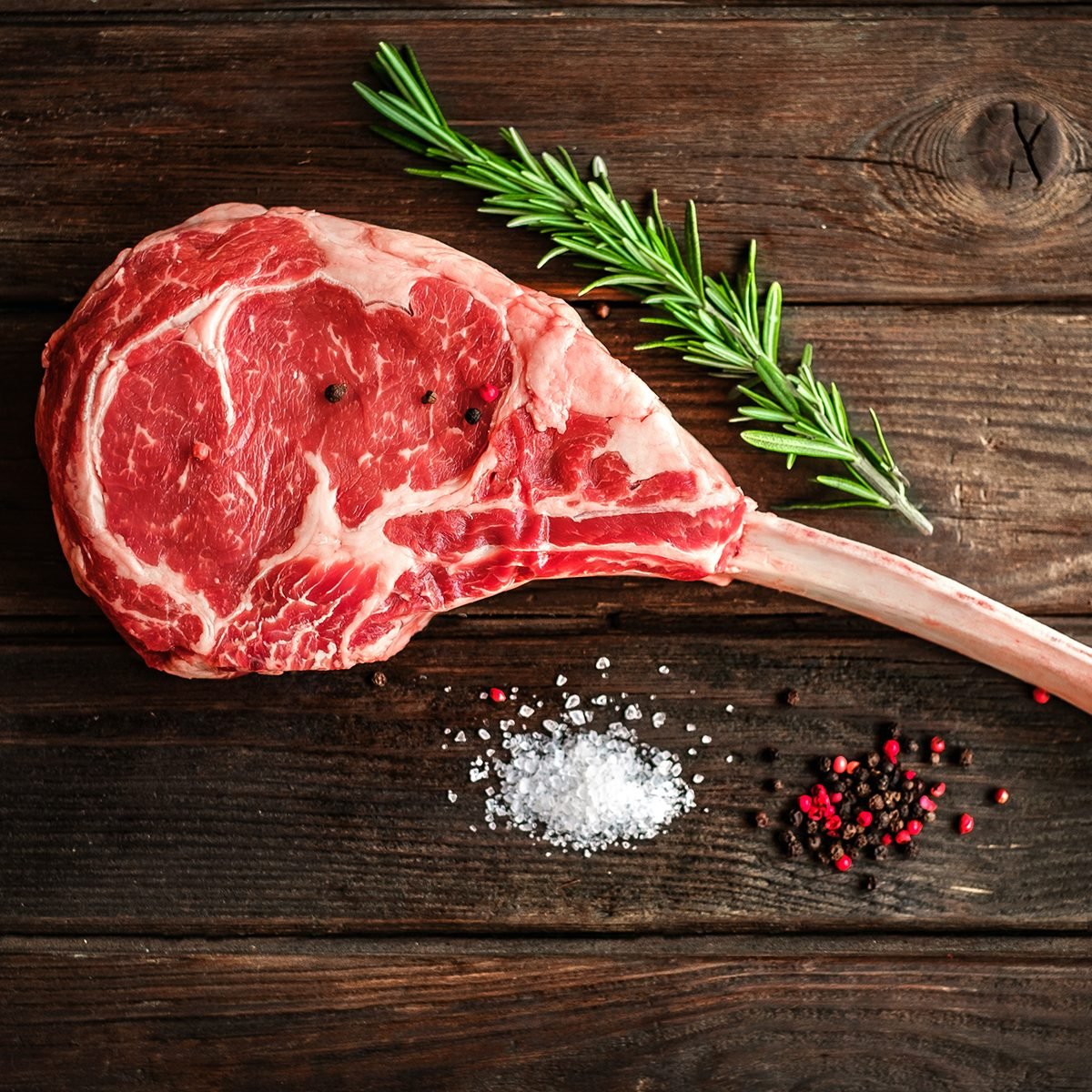
21 Steak Cuts Everyone Should Know

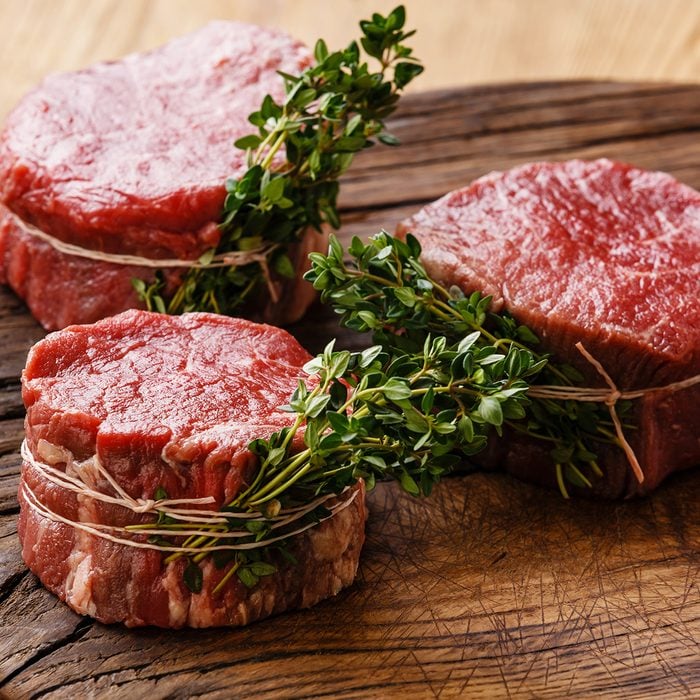
Filet Mignon
Filet mignon is cut from the beef tenderloin, a long, cylindrical muscle that runs along the spine from the short loin to the sirloin. It’s not a weight-bearing muscle and doesn’t get much work, making the meat so tender you can practically cut through it with a fork! But that also means it has almost no connective tissue or fat, so it’s prone to overcooking. I also find it less flavorful than other steaks, so I usually serve filet mignon with a rich sauce.
Other beef tenderloin steaks that cook similarly to filet mignon are tournedo steaks (smaller steaks cut from the narrow end of the tenderloin) and chateaubriand (center-cut steaks).
How to cook it: I like to salt filet mignon steaks at least 45 minutes ahead of time to concentrate the meat’s flavor. Pan-searing filet mignon in a cast-iron skillet is a good option for creating a crusty sear (and enough fond to make a tasty pan sauce in the pan afterward). Keep an eye on the internal temp and consider cooking medium-rare steak here; the steaks have almost no fat content, so they can easily overcook and taste dry.
Best filet mignon recipes: Steak and onions, saucy steak Diane, crab-topped steak Oscar or surf and turf recipes with lobster tail
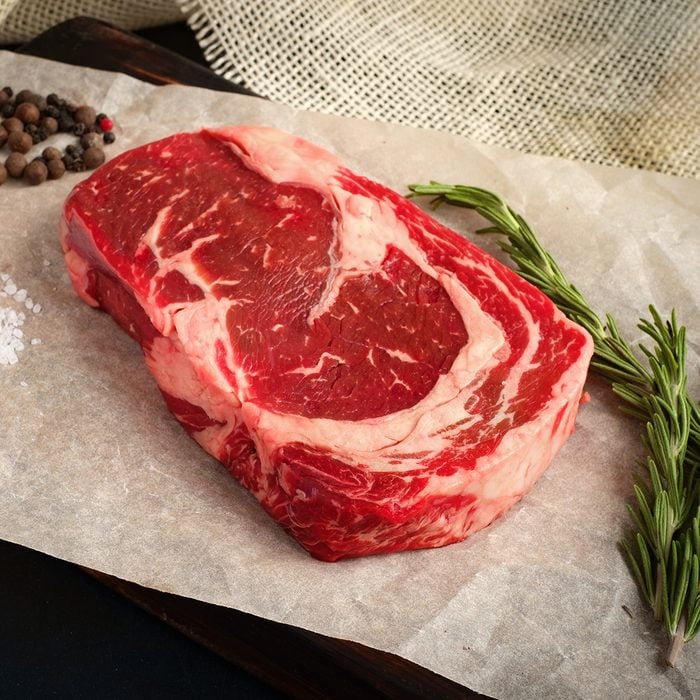
Ribeye Steak
Ribeye steaks are bone-in or boneless steaks cut from the center of the rib section. They’re some of the juiciest, most well-marbled steaks on this list! All the extra fat makes the ribeye more flavorful (though slightly chewier) than filet mignon. The intramuscular fat also makes it forgiving to cook, as it keeps the meat juicy even if slightly overcooked. When shopping, look for ribeyes with good marbling and a nice fat cap on the top.
If you love ribeye steaks, you’ll probably enjoy other cuts from the rib section, like ribeye roast and prime rib.
How to cook it: Season a ribeye simply with salt and pepper to accentuate its beefy flavor. Then cook it over dry heat—I like to use a grill for bone-in ribeye and a griddle or cast-iron pan for boneless ribeye. I think it tastes best at medium-rare temperatures, but it’ll still be great at more well-done temperatures.
Best ribeye steak recipes: Grilled ribeye steak, sweet coffee-rubbed ribeyes or marinated ribeyes. Bonus: this cowboy butter pairs perfectly with any ribeye
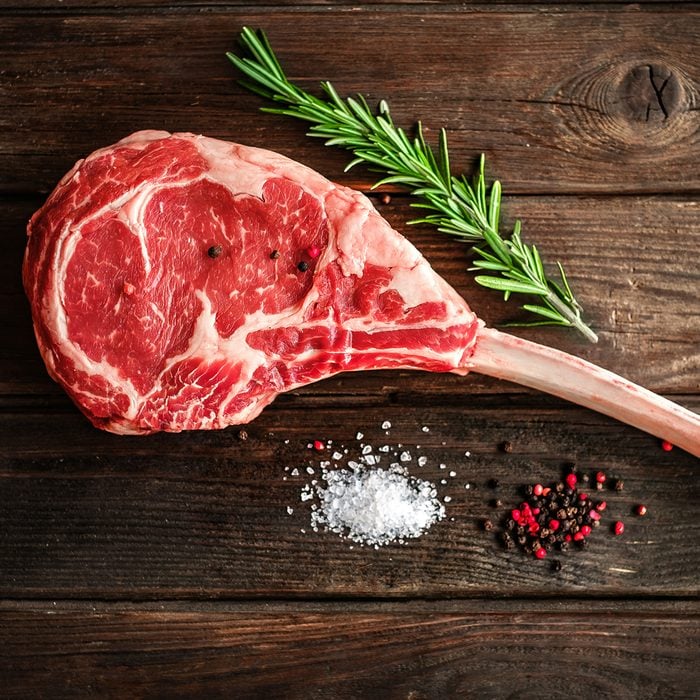
Tomahawk or Cowboy Steak
Tomahawk and cowboy steaks are a type of bone-in ribeye steak. Here, the long rib bone is left intact, giving the steak a Flintstone-looking appearance. Cowboy steaks have a shortened bone, whereas tomahawk steak bones are long enough to serve as a handle. Either way, the bone is usually “frenched” (or cleaned of fat and gristle) to create an elegant appearance. These steaks are generally about 2 inches thick and large enough to feed several people.
How to cook it: This steak looks intimidating, but you just need to know how to cook a thick steak to pull it off. Sear the tomahawk or cowboy steak in a cast-iron pan or over direct heat on the grill. Then, finish cooking it in the oven or on the indirect heat side of the grill. Before serving, carve the meat off the bone. Slice it into pieces, and position the sliced steak beside the bone to create an unforgettable steak platter.
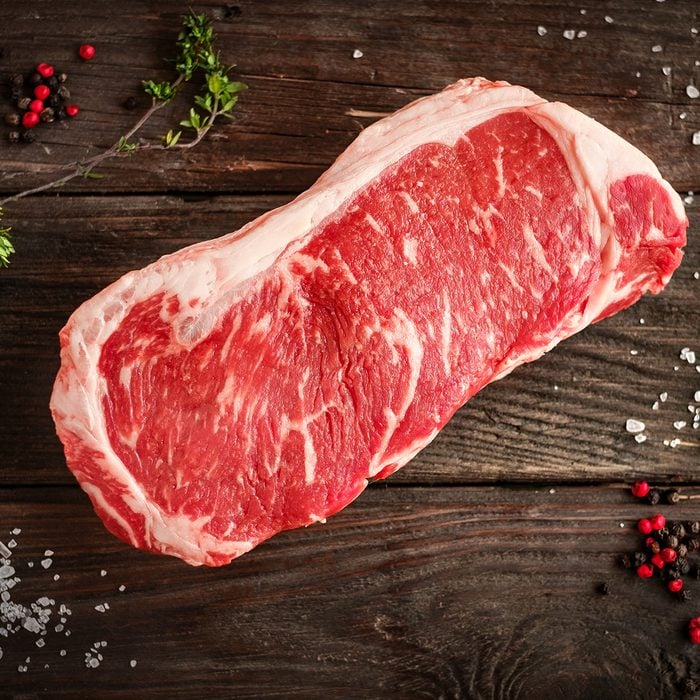
Strip Steak
Strip steak is a flavorful cut from the short loin, which is located between the rib and sirloin. This is one of my personal favorites because it’s well-marbled but not as fatty as a ribeye (so I feel a little better about myself when eating one!). It’s perhaps slightly chewier but has a more beef-forward flavor. Look for strip steaks cut from the middle of the short loin. You can identify the chewier end-cut strip steaks by the visible nerve running down the middle of the steak.
This steak may be labeled as a New York or Kansas City strip. As the story goes, New York restauranteurs in the 1930s rebranded the steak to improve sales. It’s almost always sold as a boneless steak, as leaving the bone intact turns strip steak into a T-bone or porterhouse (more on those steaks in a minute).
How to cook it: Prepare a strip steak like a ribeye by seasoning it with salt and pepper (or steak seasoning) and cooking it over dry heat like a grill or cast-iron skillet. I find these steaks chewy when prepared rare, so I like to cook them between medium-rare and medium. When cutting strip steaks, be aware of a piece of silverskin that runs underneath the fat cap. I usually leave it intact when serving family and carve it off if I’m serving company.
Best strip steak recipes: Steak au poivre or any grilled steak recipes that call for other steaks
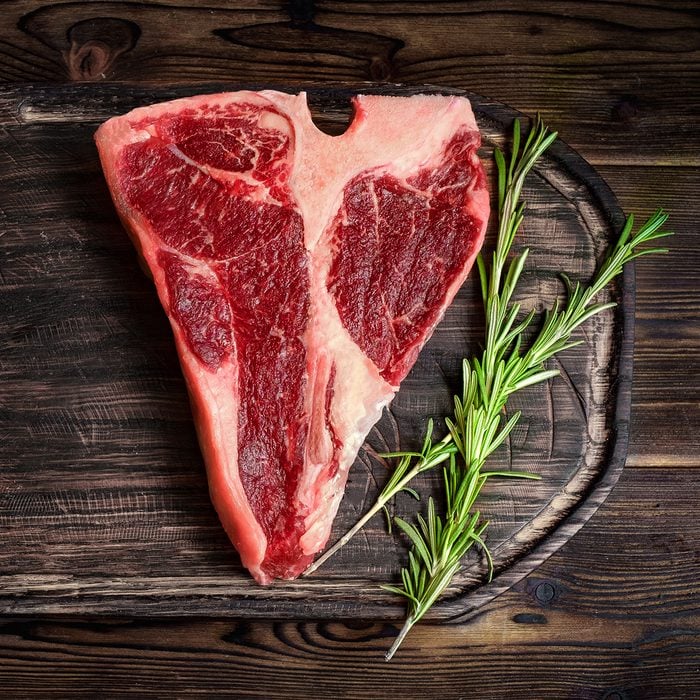
T-bone Steak
T-bone steak features a tenderloin and strip steak separated by a “T-shaped” bone. It’s a favorite amongst meat lovers because it represents the best of both worlds: The fat-rich marbling of strip and the tenderness of filet mignon. To qualify as a T-bone, the filet portion of the steak must be at least 1/4 inch thick.
How to cook it: Cook T-bone steak over dry heat like a strip steak. I recommend using an instant-read meat thermometer to ensure each side of the bone reaches the ideal temperature. After it rests, carve the meat from each side of the bone and replace it around the bone after slicing (similar to a tomahawk steak presentation).
Best T-bone steak recipes: Savory grilled T-bones or garlic-rubbed T-bones with burgundy mushrooms

Porterhouse
All porterhouse steaks are T-bones, but not all T-bone steaks are porterhouses. Let me explain: Both steaks contain a strip and tenderloin steak separated by a T-shaped bone. However, the porterhouse is cut from the back of the loin, where the tenderloin is the thickest. According to the USDA labeling requirements, a porterhouse must be at least 1-1/4 inches thick.
If you ever see bistecca alla fiorentina or Florentine steak on the menu at an Italian restaurant, chances are good you’re getting a porterhouse. True Florentine steak is cut from Chianina cattle (a Tuscan breed prized for its lean meat).
How to cook it: Because it’s much thicker than a T-bone, I like to cook a porterhouse steak like a tomahawk or cowboy steak. Sear the steak on the stovetop or direct-heat side of the grill. Once browned and caramelized, finish cooking the steak in the oven or indirect heat. Carve a porterhouse like a T-bone steak.

Bone-In Filet
A bone-in filet is similar to a filet mignon, but it’s cut from the filet side of the porterhouse steak. It’s thicker than a typical filet mignon but has the same buttery texture and shockingly tender bite. Bone-in filet is difficult to find, but I think it’s worth seeking out at a specialty butcher shop. Leaving the bone intact makes it significantly more flavorful than its boneless counterpart.
How to cook it: Cook bone-in filet like a boneless filet, adjusting the cooking time slightly. Bone-in meat typically takes longer to cook than boneless cuts.

Top Sirloin Steak
Top sirloin steak is cut from the top of the sirloin section closest to the short loin, making it the most tender of the sirloin steaks. If I had to choose a single favorite steak, top sirloin would be it. These boneless steaks have a similar texture to strip steak. They’re significantly leaner yet exhibit enough fat marbling to stay juicy when cooked to medium-rare temperatures. I also find them beefier and more flavorful than steaks from the rib or short loin. Plus, they tend to be less expensive: win-win-win!
How to cook it: You can treat top sirloin like a strip steak and season it simply with salt and pepper (or dress it up with a dry rub). Marinating it for a few hours (or overnight) isn’t a bad idea, either. Sirloin doesn’t have much fat or intramuscular marbling, so it can taste dry when cooked to temperatures over medium. A marinade builds in a bit of juiciness protection and makes the meat taste less chewy.
Best top sirloin recipes: Grilled sirloin steak, steak and potatoes or steak and mushrooms
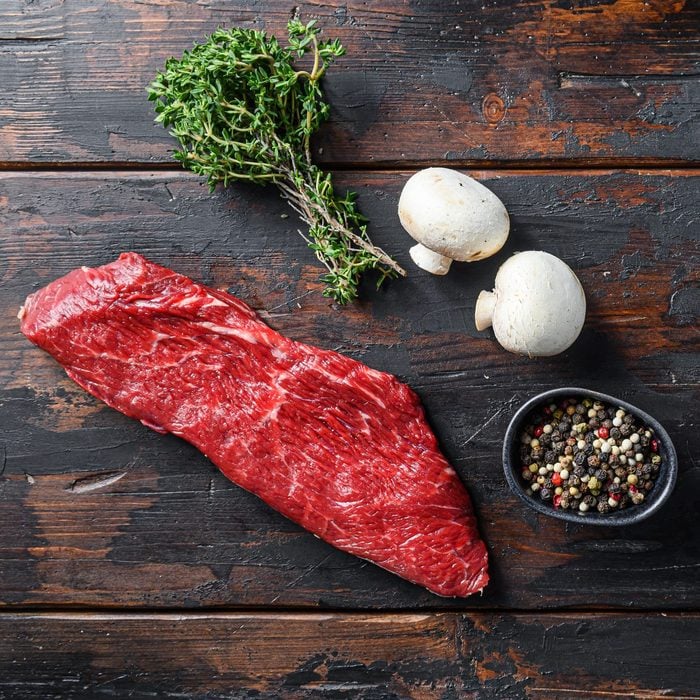
Tri-Tip Steak
In general, the bottom sirloin is less tender than the top sirloin—except in the case of tri-tip. Also called Santa Maria steak, this steak is sliced off the triangular-shaped tri-tip roast. It has a distinctively robust flavor and tastes fantastic on the grill, especially when used to make sandwiches or tacos.
In a pinch, you can substitute sirloin tip for tri-tip. However sirloin tip steak is cut from the top sirloin, so it’s slightly less flavorful.
How to cook it: Like other sirloin steaks, tri-tip steak is lean. I recommend marinating it for at least 8 hours (or overnight). It can be broiled or pan-seared, but it really tastes best cooked to medium-rare temperatures on a hot grill. After it rests, slice it against the grain to avoid chewy pieces of steak.
Best tri-tip steak recipes: Grilled tri-tip steak (either marinated with the marinade from tri-tip roast or dry rubbed with the seasonings from Santa Maria roast beef)

Coulette Steak (Picanha)
Known as picanha in Brazilian cuisine, coulette steak is a well-marbled steak cut from the top sirloin cap. It’s as beefy as top sirloin, but its higher levels of intramuscular fat give it a buttery tenderness. It’s sometimes sold with the fat cap intact, but it can be removed so the steak resembles sirloin steak.
How to cook it: Coulette steak doesn’t need to be marinated. Like other sirloin steaks, it’s best to cook this relatively lean steak using a hot-and-fast cooking method (like grilling or pan-searing) to avoid drying out. Take note of the grain when slicing coulette steak, and slice against the long muscle fibers to reduce their chew to a single bite.
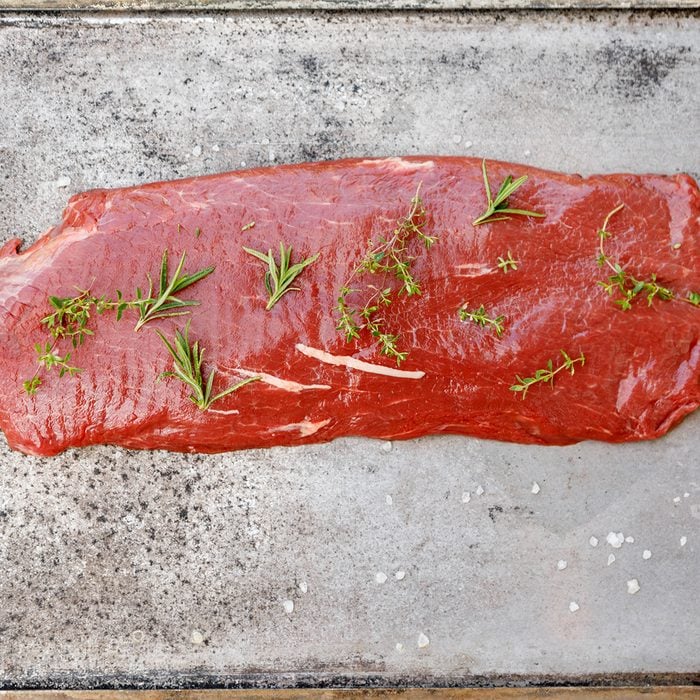
Flat Iron Steak
The chuck is a large primal that spans the cow’s front shoulder. It’s not exactly known for its tenderness—most chuck roast recipes are cooked low and slow to break down the connective tissue. But there are a few tender steaks hiding in the well-worked muscles, starting with the flat iron steak.
Flat iron is taken from the upper portion of the shoulder blade and has a triangular shape that resembles an iron. It has all the beefy flavor of a chuck roast without the chewiness. The muscle has a tough sinew running through its middle, but a good butcher will portion steaks around this seam for maximum tenderness.
How to cook it: Flat iron cooks similarly to sirloin steak. It can benefit from a marinade (although it’s not required) and tastes most tender when cooked to medium-rare temperatures in a hot pan or grill.
Best flat iron steak recipes: Grilled flat iron steak or flat iron steak salad
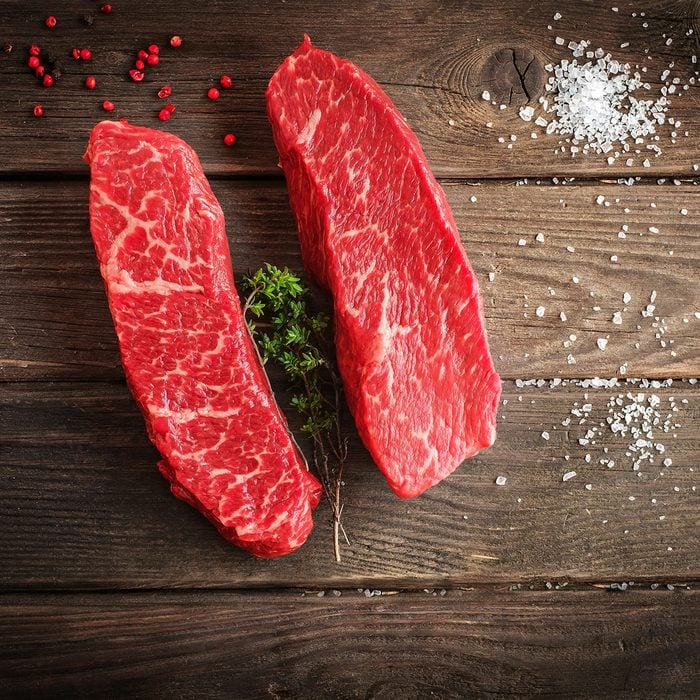
Denver Cut
I only learned about Denver steak a few years ago, and it quickly made my list of top favorite steaks. Also called bottom chuck or underblade steak, it’s cut out of the eye of the chuck. Unlike the tough shoulder meat surrounding it, the serratus ventralis muscle sits underneath the shoulder blade and sees very little exercise. The result is an inexpensive steak marbled like a strip steak but without all the excess fat.
How to cook it: Season Denver steak simply with salt and pepper and cook it over high heat like a strip steak. These steaks also cook exceptionally well using reverse-sear techniques, where the meat is first cooked over indirect heat (or via sous vide cooking). When it’s 10° to 15°F below the desired temperature, the steak is finished over direct heat to create a caramelized crust.

Chuck Steak
Chuck steak can describe several steaks cut from the chuck or front shoulder muscle. These steaks are incredibly beefy tasting but vary in their levels of connective tissue and intramuscular fat, which affects their tenderness. Outside the steaks described above, the most tender chuck steaks are chuck-eye steak, shoulder petite tender medallions or lean center-cut shoulder steak (aka ranch steak). When cut into 2-inch rib-shaped pieces, chuck steak is called boneless beef short ribs.
How to cook it: Marinate chuck steak overnight to tenderize the tough muscle fibers. Then, grill chuck steaks over medium heat instead of high heat to slow the cooking process a little. They can also be baked in a 325° oven. I like to cook chuck steak to medium temperatures, as lesser-done chuck steak can be a little chewy.
Best chuck steak recipes: Grilled chuck steak, grilled short ribs or oven-roasted boneless beef short ribs
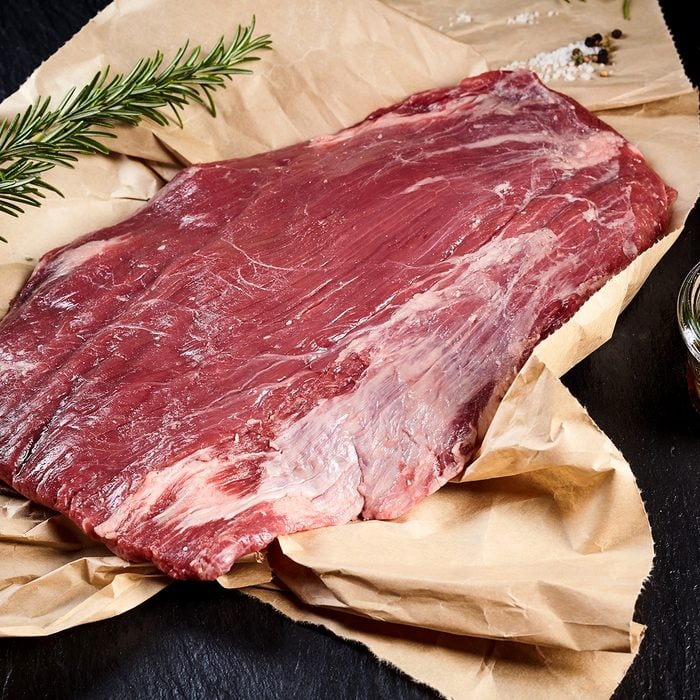
Flank Steak
Flank steak is the only steak cut from the flank primal, a long, flat muscle located along the belly towards the hindquarter. Also called jiffy steak, flank steak is thicker and wider than skirt steak, and it tends to be slightly more tender. Because it contains high levels of connective tissue, flank steak should be marinated overnight. It should either be cooked to medium-rare temperatures or cooked low-and-slow until shreddable. Anywhere in between, and the meat will taste tough.
How to cook it: Marinate flank steak in an acidic marinade containing ingredients like citrus juice or vinegar. I like to cook flank steak on the grill to bring out its meaty flavor, but it also tastes great when roasted in the oven or seared on the stovetop. For the best eating experience, cook flank steak to medium-rare and slice it thinly against the grain, or slow-cook flank steak until it’s tender and shreddable.
Best flank steak recipes: Marinated flank steak, teriyaki steak, steak pinwheels, stuffed flank steak or slow-cooker carne asada
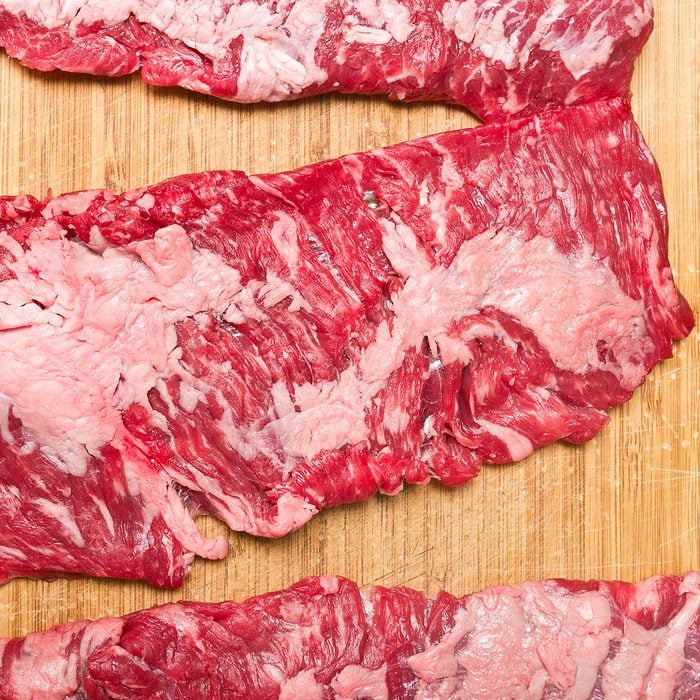
Skirt Steak
The skirt steak is a long, thin muscle cut from the plate, or the belly section closest to the forequarter. There are two types of skirt steak. The outside skirt is cut from the diaphragm muscle, making it narrower, thicker and more tender. The inside skirt is cut from the more well-worked transverse abdominal muscle. The wider, thinner muscle is a little chewier and tougher, so I like to lightly pound it with a meat mallet to make tough meat tender.
Flank steak and skirt steak can generally be used interchangeably, although skirt steak is slightly tougher. The steak may be labeled “arrachera,” but ask your butcher to be sure. Sometimes, arrachera can refer to flap meat or flank steak.
How to cook it: Marinate skirt steak in an acidic marinade and flash sear it over high heat until it reaches medium-rare to medium temperatures. Once cooked, cut the steak against the grain to avoid chewy bites.
Best skirt steak recipes: Grilled skirt steak, skirt steak tacos or use it as a substitute in your favorite flank steak recipes
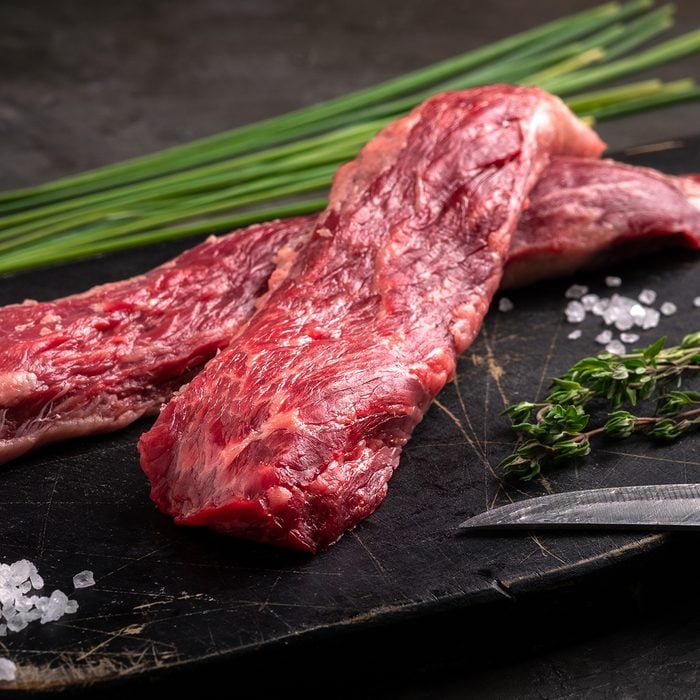
Flap Steak (Bavette)
Flap meat doesn’t necessarily sound appetizing, but it’s an affordable, versatile cut that tastes great. Also called sirloin flap or bavette, this cut comes from the very bottom of the sirloin close to where it meets the flank section, making it more like a flank or skirt steak than other sirloin steaks. It can generally be used as a substitute for flank or skirt steak.
How to cook it: Marinate flap steak and cook it over high heat like flank or skirt steak. The lean meat tastes best when cooked to medium-rare to medium temperatures.
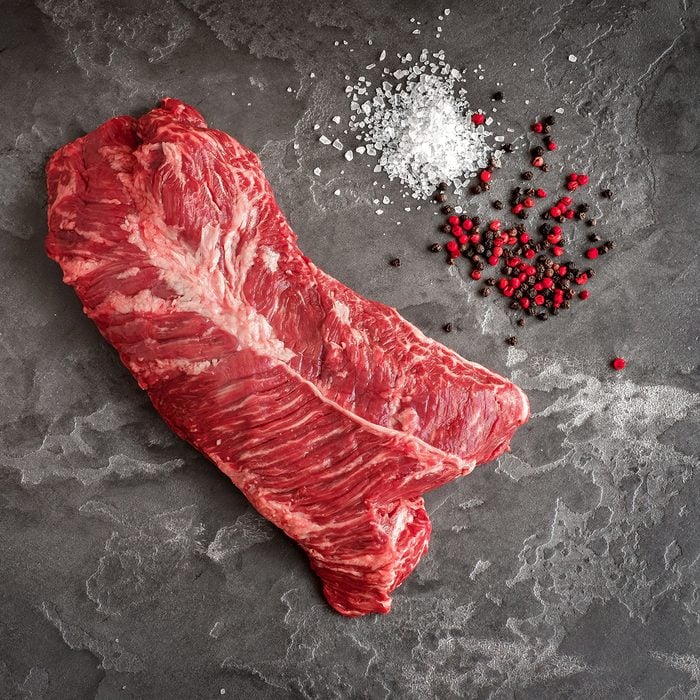
Hanger Steak (Onglet)
Known as onglet in France, hanger steak comes from the plate or belly section of the cow, but it’s not connected to any bones. It hangs from the diaphragm, hence the nickname “hanging” steak. It’s relatively inexpensive and has a super beef-forward flavor. The whole hanger is separated by a thick, inedible membrane that runs down its center. If you want to avoid doing any butchery at home, ask the butcher to remove the membrane and cut the hanger into individual steaks.
How to cook it: Like skirt or flank steaks, hanger steaks benefit from a marinade with a strong acidic component. Cook the steak over high heat, and be sure to cut against the grain before serving. You can cook hanger to medium-rare, but I think it’s less chewy when cooked to medium or medium-well temperatures.
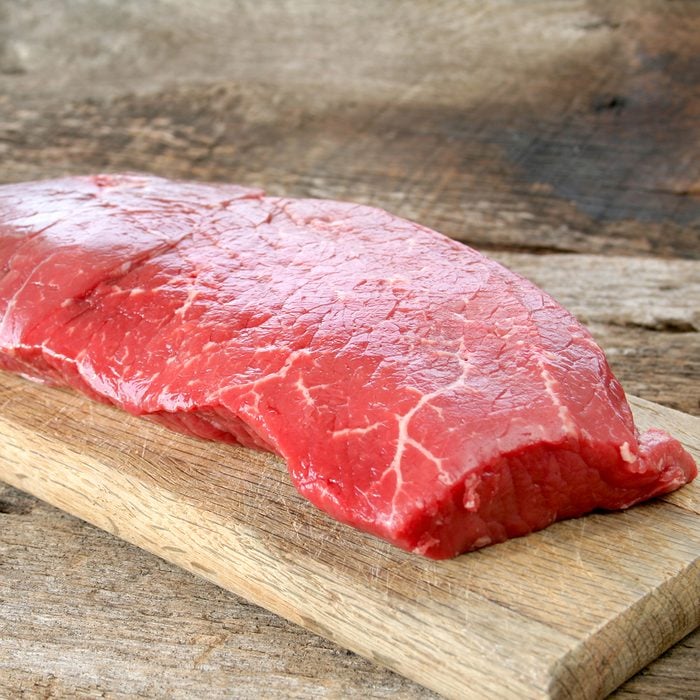
Top Round Steak (London Broil)
As the name indicates, the top round steak is cut from the top of the round primal located at the beef’s hindquarter. It’s often labeled as London broil (which is technically a cooking method, not a cut of meat). However, be careful with this labeling, as some butchers sell flank steak under the London broil label.
Top round steaks aren’t the best candidate for grilling. They’re significantly leaner than chuck steaks, so they can dry out and taste tough—even when marinated. Most round steak recipes use low-and-slow cooking techniques, although you can also use the meat to make beef jerky.
How to cook it: Pound round steaks until they’re 1/4-inch thick. Bread them with breadcrumbs to make milanesa steak, or leave them unbreaded for Cuban-style palomilla steak. Pan-fry the steaks in a hot pan for a few minutes a side. For thicker steaks, slow-cook the seared steaks in a sauce until tender.
Best top round steak recipes: Easy London broil, Swiss steak, round steak and gravy or slow-cooker round steak
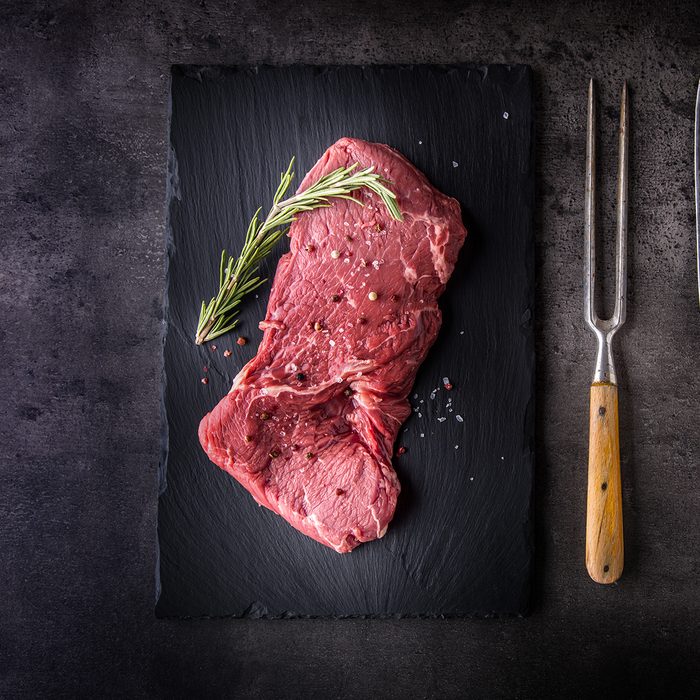
Rump Steak (Bottom Round)
Rump steak (sometimes called bottom round steak) comes from the beef’s hindquarter. Although the bottom round is quite lean and can taste tough when overcooked, these steaks can taste similar to a ribeye steak but with the leaner consistency of sirloin steaks. Like top round steaks, it’s best to avoid grilling rump steak.
How to cook it: Cook rump steak like top round steak, pounding it to 1/4- to 1/2-inch thickness and marinating it for at least four hours. Sear the steak in a cast-iron pan until it reaches medium temperature. Make sure to slice round steak against the grain.
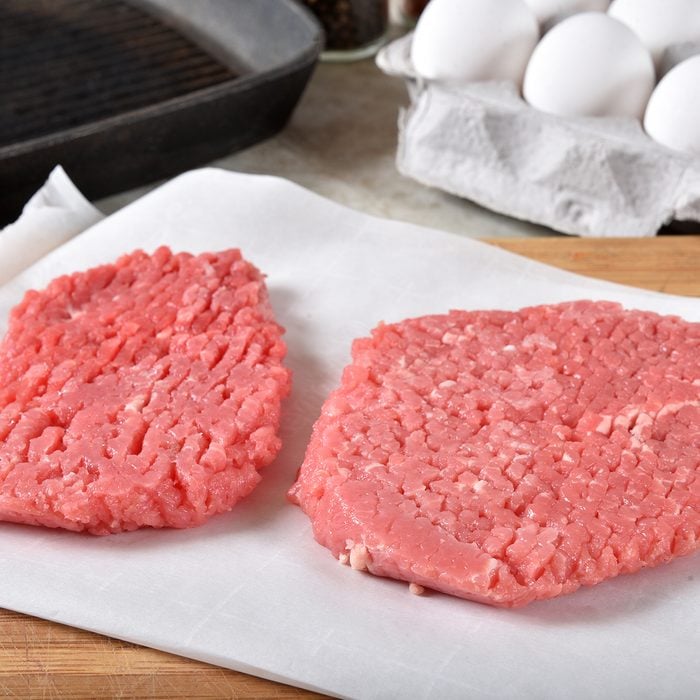
Cube Steak
Cube steak is a pre-tenderized thin cut of meat from the beef round. The steaks are usually mechanically tenderized and riddled with dozens of little cuts on the surface. They cook very quickly, but it’s almost impossible to cook them to any temperature other than well-done.
How to cook it: Like other round steaks, cube steaks are best suited for breading and pan-frying. They’re often served with a rich gravy to cover up any dry texture. Cube steak can also be slow-cooked until tender.
Best cube steak recipes: Slow-cooker cube steak, chicken-fried steak or country-fried steak

Salisbury Steak
Although not technically a steak, Salisbury steak is a ground beef patty shaped like a steak. The seasoned hamburger steak falls somewhere between a meatloaf and a burger, but its meaty texture will satisfy steak cravings on a budget.
How to cook it: Form the beef patties and sear them in a skillet until browned on all sides. Then simmer the steaks in gravy on the stovetop or in a slow cooker.
Best Salisbury steak recipes: Salisbury steak with homemade gravy, easy Salisbury steak or slow-cooked poor man’s steak
Steak Cuts FAQ
What are the most tender steaks?
The most tender steaks come from lesser-worked muscles with little or no connective tissue. Filet mignon is generally considered the most tender steak, although ribeye, strip steak, T-bone, porterhouse, Denver steak and flat iron are also considered very tender.
What is the leanest cut of steak?
Round steak is considered the leanest cut of steak, but it’s not the most tender. Other cuts of beef with a limited amount of fat include filet mignon, top sirloin, tri-tip, flank and center-cut chuck shoulder steak (aka ranch steak).
How do you cut steak against the grain?
To cut steak the right way, locate the grain (the muscle fibers that run parallel to each other) and position your knife in a “T” to the fibers. This shortens the fibers to the length of the slice, making the steak easier to chew (and thus taste more tender).
What temperature do you cook steak?
We recommend cooking most steaks to medium-rare (135°), although the best temperature for steak is a matter of personal preference. You can cook steak to rare (130°) for a cool red center, medium-rare (135°) for a warm red center, medium (140°) for a warm pink center, medium-well (145°) for a warm slightly pink center, or well-done (150°) for a hot brown center.





















